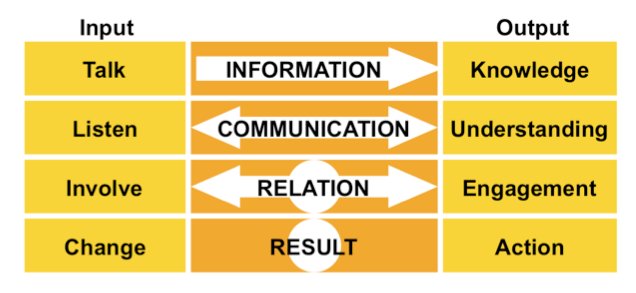|
Communication definition
Communication comes from the Latin word “communicare”, which mean, “to share” or “doing together”. Well that’s odd. It doesn’t mean spreading information? In a modern society however, the communication definition has got a much larger meaning. I like to see it like this: There are four levels of communication and it gives you different levels of result.
Examples of channels are: Large meetings, department meetings (you would be surprised by how much of this meetings are one-way), Intranet, billboards, newspapers, email etc. 2. Next level is ”two-way communication”. To create this you will have to add listening to the talking. You talk and somebody replies. This is what we call a discussion. Now, this doesn’t mean that we get people motivated or engaged, not yet, but we are able to create understanding. Example of channels are: telephone, small group meetings (can be one-way too of course), informal conversations etc. 3. In order to create engagement you have to involve them. People want to feel that their opinion count. If you want people to be engaged make them a part of the decision process. This does not mean that you need to have a complete democracy. No company is a democracy. But, there are different levels of decisions in a decision process. E.g. the company or you, as a leader, decides the WHAT. Let your people be a part of deciding the HOW. More on this in Change When it comes to channels in this level, there is basically only one, and that is dialogue. Real dialogue. Read more on how you create dialogue and how you can see the difference between dialogue, discussion and debate, by clicking here. 4. Finally, the last level. This is where you go to action. There is an old saying: ”If you always do what you always done you will always get what you always got” (hmm). The point being: If you want action you need to do something different. You can always get action by yelling orders, no argument about that. But you want a sustainable action and therefore you want to go through knowledge – understanding – engagement – action. Why doesn’t this work? Talking ≠ Action! The mistake many managers do is that they assume that when they send out information (level 1) the result will automatically be that people will act. It just doesn’t work that way. If you want to get action you have to take it from level 1 all the way down to level 4. The difference between Communication and Communications My old boss, Kevin Thomson at MCA Ltd, explained to me sometimes back in the late 90’s that the letter S was the most expensive letter in the world. He said, that communication consultants has for many years told their clients that they will help improve “communications” and their clients has heard: improve “communication”. The difference is the letter S. but the meaning of that letter is enormous. Communication means the process where two or more people send and receive messages with the intention of improving knowledge and understanding and changing behaviour. Communications on the other hand means the channels used for communication. So, what the consultants are saying is: let us help you improve your communication channels! The results, being, that most companies has got excellent Intranets and magazines etc. But poor communication. “Put it on the web” is probably the most common phrase among managers. What they mean: “Put it on the web so that people read it, understands it and acts on it”. But that won’t happen!
|





 1. The first level in my model is “one-way communication”, or “Information”, as some people like to call this. Usually this mean that somebody is talking to a target group (regardless of channel). In the other end of the process you manage to build knowledge. In my experience it is in “information” that you find the bulk of all communication in a company. In many cases as much as 90-95% of all communication is found here.
1. The first level in my model is “one-way communication”, or “Information”, as some people like to call this. Usually this mean that somebody is talking to a target group (regardless of channel). In the other end of the process you manage to build knowledge. In my experience it is in “information” that you find the bulk of all communication in a company. In many cases as much as 90-95% of all communication is found here. 